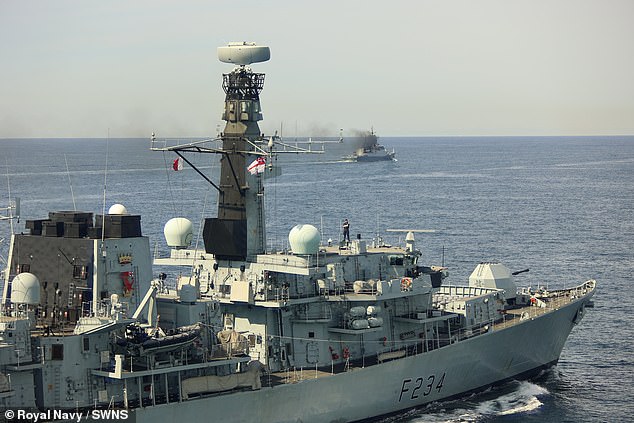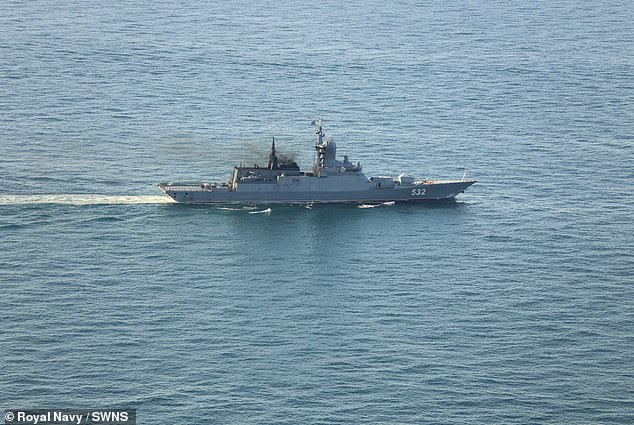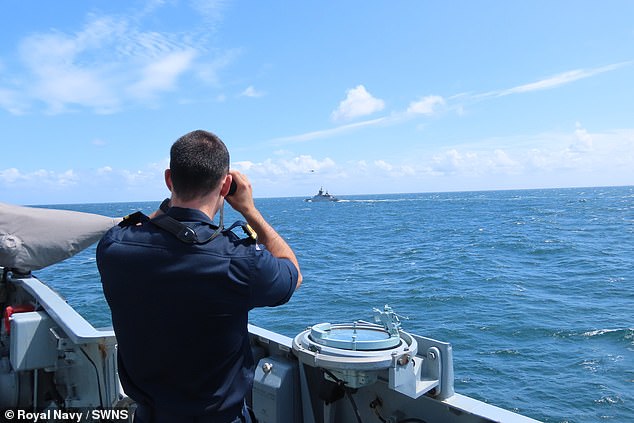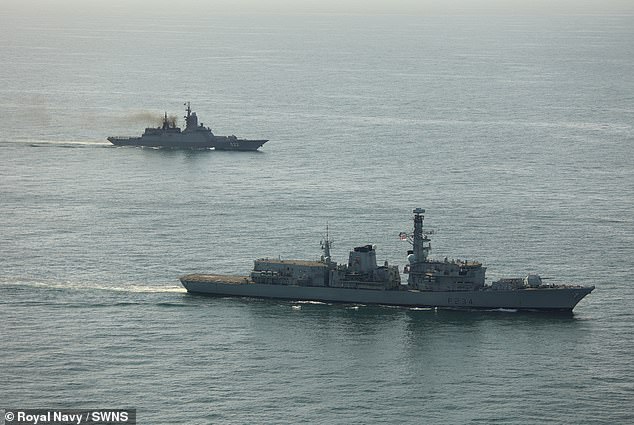Royal Navy warships and helicopters have shadowed five Russian vessels in UK waters over the first week of July alone, as Vladimir Putin continues to test Britain’s defence capabilities.
Plymouth-based frigate HMS Iron Duke, Portsmouth-based patrol ship HMS Tyne and Wildcat aircraft from 815 Naval Air Squadron were dispatched on three separate operations in the North Sea and English Channel between July 1 and today.
The warships worked closely with NATO allies as they kept constant watch on the Russian vessels, including two Steregushchiy-class corvettes, a tanker, bulk carrier and a Smolnyy-class training ship, as they passed through UK waters.
‘This all took place as allied nations took part in a significant exercise in Portland aimed at helping Ukraine make the Black Sea safe,’ the Royal Navy said in a statement.
It comes amid new warnings that Russia could soon pose a credible threat to Europe, one which would only be deterred with a rapid increase in defence spending.
‘Strengthening Europe’s defense industry is an absolute top priority, and we have to be able to defend ourselves by 2030 at the latest,’ Danish Prime Minister Mette Frederiksen warned today.
‘Never, ever should we allow Europe to be put in a position again where we cannot defend ourselves,’ he added during a speech to the European Parliament.
A report out today claims that Rotterdam, Europe’s largest port, is gearing up for a potential conflict with Russia by reserving space for ships carrying military supplies.

Commanding Officer of HMS Iron Duke Commander David Armstrong atop the ship bridge roof during monitoring of RFN Boikiy

RFA Boikiy. Royal Navy warships and helicopters have shadowed five Russian vessels in UK waters over the first week of July

HMS Iron Duke tracks RFN Soobrazitelny. It comes amid new warnings that Russia could soon pose a credible threat to Europe

Wildcat aircraft from 815 Naval Air Squadron have also been tracking Russian vessels in UK waters. Pictured: HMS Iron Duke shadows RFN Boikiy
Boudewijn Siemons, chief executive of the Port of Rotterdam Authority, told the Financial Times that it was planning how to manage if the port was flooded by British and US vehicles and supplies if needed.
NATO Secretary-General Mark Rutte has warned that while Europe is not currently at war, it is not at peace either.
Russia has been accused of acts of sabotage, cyberattacks and fake news campaigns, designed to weaken European support for Ukraine, according to officials.
Last week, one of Putin’s deadly attack submarines was also shadowed by the Royal Navy off the English coast.
The RFN Novorossiysk, a heavily armed Kilo-class sub, was detected as it made its way through the North Sea and into the English Channel.
Patrol ship HMS Mersey, based in Portsmouth, was scrambled to intercept the Russian boat, while a Wildcat helicopter and specialist submarine-hunting Merlin aircraft from 824 Naval Air Squadron were also deployed in the air.
Many European leaders insist they have heard the Trump administration’s warning that American security priorities now lie elsewhere – in the Middle East and the Indo-Pacific.
At a key summit last month, NATO leaders endorsed a statement saying: ‘Allies commit to invest 5 per cent of GDP annually on core defense requirements as well as defense- and security-related spending by 2035 to ensure our individual and collective obligations.’
That historic pledge will require them to spend tens of billions of euros more over the coming decade instead of the suggested five years.
Spain – NATO’s lowest spender with 1.28 per cent of GDP last year – quickly branded the target ‘unreasonable.’
Belgium has cast doubt over whether it will make the grade. Slovenia is considering a referendum.
Heavyweights France and Italy are mired in economic woes and will struggle to get there too.
Money spent on military support to Ukraine can now be included in NATO’s defense calculations, but even that will not hike the GDP military spend by much.
With the threat of Russian aggression in mind, the EU’s executive branch has come up with a security plan.
It hinges on a 150-billion-euro loan program that member countries, Ukraine and outsiders like Britain could dip into, and aims to fill gaps that the US might leave.
Spending priorities for joint purchase include air and missile defense systems, artillery, ammunition, drones, equipment for use in cyber and electronic warfare, and ‘strategic enablers’ like air-to-air refueling and transport.











